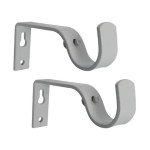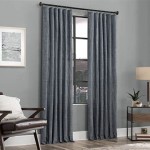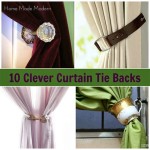Tension Rods for Window Curtains: A Comprehensive Guide
Tension rods offer a versatile and damage-free solution for hanging curtains without the need for drilling or permanent fixtures. These adjustable rods rely on pressure to stay in place, making them ideal for renters, those seeking temporary window treatments, or anyone wishing to avoid damaging walls. Understanding the different types, features, and installation techniques of tension rods is essential for selecting the right product and ensuring a secure and aesthetically pleasing result.
The fundamental principle behind a tension rod's functionality lies in its spring-loaded or telescoping design. When extended between two surfaces, such as the inside of a window frame, the rod exerts outward pressure. This pressure, combined with the friction between the rod's end caps and the mounting surfaces, creates a force that holds the rod securely in place. The amount of weight a tension rod can support depends on several factors, including the rod's diameter, the material it's made from, the quality of the spring mechanism (if applicable), and the condition of the mounting surfaces.
Types of Tension Rods
Tension rods are not a one-size-fits-all solution. They come in various designs, each with its own strengths and use cases. Understanding the different types is vital for selecting the most appropriate option for specific window sizes, curtain weights, and aesthetic preferences.
Spring Tension Rods: These are the most common type of tension rod. They consist of two telescoping sections with a spring mechanism inside. When compressed, the spring creates the necessary tension to hold the rod in place. Spring tension rods are typically affordable and suitable for lightweight curtains. They are best suited for situations where precise length adjustments are not critical, as the spring compression provides a fixed range of adjustability.
Telescopic Tension Rods: Also known as friction rods, these lack an internal spring. Instead, they rely solely on friction between the telescoping sections and the mounting surfaces to stay in place. These rods are generally sturdier than spring tension rods and can support heavier curtains. They offer a wider range of adjustability, allowing for more precise length adjustments. The strength of a telescopic tension rod depends heavily on the quality of its locking mechanism and the tightness of the friction fit.
Curved Tension Rods: These rods offer a unique aesthetic and functional appeal. They curve outwards, creating more space inside the window frame. This makes them particularly useful for shower curtains, where extra elbow room is desired, or for creating a more dramatic drapery effect with window curtains. Curved tension rods are available in both spring and telescopic designs, with the choice depending on the weight of the curtain and the desired level of adjustability.
Heavy-Duty Tension Rods: These rods are designed to support heavier curtains and draperies. They are typically constructed from thicker gauge metal and feature robust locking mechanisms. Heavy-duty tension rods are ideal for situations where standard tension rods would be insufficient, such as hanging blackout curtains, thermal curtains, or multiple layers of fabric. They often feature wider end caps for increased surface area and improved grip.
Factors to Consider When Choosing a Tension Rod
Selecting the right tension rod involves careful consideration of several factors to ensure a secure and satisfactory outcome. Overlooking these aspects can lead to instability, curtain slippage, or even damage to the window frame or walls.
Window Size and Shape: The width of the window is a primary consideration. Tension rods come in various lengths, and it's crucial to choose one that falls within the adjustable range for the specific window. Consider the shape of the window frame. Are the surfaces parallel? Are there any obstructions that might interfere with the rod's placement? For unusually shaped windows, custom solutions or alternative hanging methods might be necessary.
Curtain Weight: The weight of the curtains is a critical factor. Lighter curtains can be supported by standard spring tension rods, while heavier curtains require a more robust telescopic or heavy-duty rod. Exceeding the weight capacity of a tension rod can lead to sagging, slippage, or even collapse. Always check the manufacturer's specifications for the maximum weight limit.
Rod Material: Tension rods are typically made from metal, such as steel or aluminum. Steel rods are generally stronger and more durable, while aluminum rods are lighter and more resistant to rust. Consider the environment where the rod will be used. In humid environments, a rust-resistant material is essential. The finish of the rod should also be considered for aesthetic purposes and to ensure it complements the curtains and the overall décor of the room.
End Cap Design: The end caps of a tension rod play a crucial role in its stability. Wider end caps provide a larger surface area for contact, increasing friction and preventing slippage. Rubberized or non-slip end caps offer even greater grip, particularly on smooth surfaces. The material and design of the end caps should be carefully considered to ensure they are compatible with the mounting surfaces.
Adjustability: The adjustability range of a tension rod is important for achieving a precise fit. Choose a rod that offers sufficient adjustability to accommodate the specific window size and any potential variations. Telescopic rods generally offer a wider range of adjustability than spring tension rods. Ensure that the locking mechanism is secure and easy to use.
Installation and Maintenance
Proper installation is crucial for ensuring the stability and longevity of a tension rod. Following the correct steps and taking precautions can prevent slippage, damage to the mounting surfaces, and potential safety hazards.
Surface Preparation: Before installing a tension rod, thoroughly clean the mounting surfaces with a mild detergent and water. Remove any dirt, dust, or grease that could reduce friction. Ensure that the surfaces are dry before proceeding. For particularly smooth surfaces, consider using a rubberized grip enhancer to improve adhesion.
Rod Adjustment: Extend the tension rod slightly beyond the desired length. This will create the necessary pressure to hold it in place. Follow the manufacturer's instructions for adjusting the rod. With spring tension rods, compressing the spring is essential. With telescopic rods, ensure that the locking mechanism is securely engaged.
Placement and Leveling: Carefully position the tension rod within the window frame. Ensure that it is level using a level tool. An unlevel rod can lead to uneven curtain hanging and increased risk of slippage. Make any necessary adjustments to achieve perfect alignment.
Securing the Rod: Once the rod is in place and level, apply gentle pressure to the center of the rod to ensure that it is securely seated. If necessary, make further adjustments to the length or position. Avoid over-tightening the rod, as this could damage the window frame or walls.
Curtain Installation: After the rod is securely installed, hang the curtains according to the manufacturer's instructions. Distribute the weight of the curtains evenly across the rod to prevent sagging or slippage. Avoid overloading the rod with excessive weight.
Regular Maintenance: Periodically check the tension rod to ensure that it remains secure. Dust the rod and end caps to maintain optimal grip. If the rod becomes loose, re-adjust it as needed. For heavy curtains, consider adding additional support, such as brackets or adhesive pads, to prevent slippage.
Tension rods represent a cost-effective and practical solution for hanging curtains in a variety of settings. By carefully considering the factors discussed above and following proper installation and maintenance procedures, it is possible to achieve a secure, aesthetically pleasing, and long-lasting window treatment.

Kenney Twist Fit 5 8 In Tension Curtain Rod Jcpenney

Mainstays 30 To 52 Adjustable Curtain Tension Rod Oil Rubbed Bronze

Roomdividersnow 28 In 50 Tension Curtain Rod Black Trod Blk54

Exclusive Home Tension Rod 24 In To 40 White Steel Curtain Rd012917dseha1 A201 At Com

Rejuvenation Cafe Set Tension Rod 24 36 Polished Nickel

5 8 Oval Spring Tension Rod Cafe Available In Custom Sizes Rods For Curtains Window Treatment Hardware Etsy

Kenney Fast Fit No Tools 28 In 48 Adjustable Spring Tension Curtain Rod 7 16 Dia Chrome Silver Set Of 2 Kn631 40v2pk2 The Home

28 48 Twist And Shout Easy Install Curtain Rod Matte Black Room Essentials No Drill Tension Er Friendly

Tension Curtain Rod Window Bedroom Kitchen Long Heavy Duty

Sunzero 5 8 Silver Tension Curtain Rod 28 60








